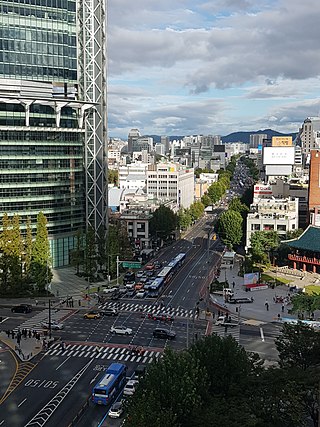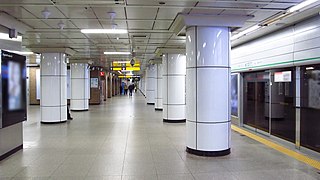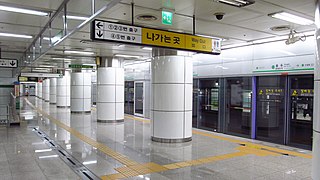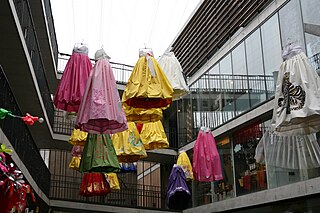
Heunginjimun, more commonly known as Dongdaemun, is one of The Eight Gates of Seoul in the Fortress Wall of Seoul, a prominent landmark in central Seoul, South Korea. The Korean name "Dongdaemun" means "Great East Gate," and it was so named because it was the major eastern gate in the wall that surrounded Seoul during the Joseon Dynasty. The gate is located at Jongno 6-ga in Jongno-gu.

Jongno or Jong-ro is a trunk road and one of the oldest major east–west thoroughfares in Seoul, South Korea. Jongno connects Gwanghwamun Plaza to Dongdaemun.

Anguk station, also known as Hyundai E & C station (Korean: 현대건설), is a subway station on the Line 3 of the Seoul Metropolitan Subway. The station is located in the Anguk neighborhood of Jongno District, Seoul and is the nearest subway station to the Insa and Samcheong neighborhoods. The station is also near the ancient royal residence of Unhyeongung.

Hyehwa Station (Korean: 혜화역) is a station on the Seoul Subway Line 4 in Jongno-gu, Seoul. It is located in the center of the area commonly known as Daehangno, and much of the ridership of this station comes from the nightlife scene. The Seoul National University Yongon campus, housing its Hospital and School of Medicine, is located to the southwest.

Sadang Station is a station on the Seoul Subway Line 2 and Seoul Subway Line 4 in South Korea.

Jonggak Station is a station on the Line 1 of the Seoul Subway in South Korea. It is located on Jongno, central Seoul and comprises a large underground arcade.

Gwanghwamun Station (Korean: 광화문역) is a station on the Seoul Subway Line 5 in South Korea. It is not the closest subway station to the actual gate of Gwanghwamun, which it is named after. It is located next to the U.S. Embassy in Seoul.

Cheonggyecheon is a 10.9-kilometre-long (6.8 mi) stream and public space in downtown Seoul, South Korea. A natural stream sourced from the Suseongdong Valley in Inwangsan, it was historically maintained as part of Seoul's early sewerage until the mid-20th century, when post-Korean War rapid economic development and deteriorating conditions prompted the filling of the stream with concrete and the construction of an elevated freeway, the Cheonggye Expressway, in its place. In 2003, the city government began an urban renewal project to disassemble the expressway and restore the stream, which was completed in 2005 at a cost of over ₩386 billion.

Jongno 3(sam)-ga Station is an underground station on lines 1, 3 and 5 of the Seoul Subway in South Korea.

Daehang-no is a area in Seoul north of the Han River within Jongno and Seodaemun districts.

Yongdu Station is a station on the Seongsu Branch of the Seoul Subway Line 2. It is located in Yongdu-dong, Dongdaemun-gu, Seoul. The name of the station means "dragon head".

Dongdaemun History & Culture Park station (Korean: 동대문역사문화공원) is a station on Line 2, Line 4 and Line 5 of the Seoul Metropolitan Subway. It is named for the nearby Dongdaemun History & Culture Park. The huge Dongdaemun Market district is centered on this station and Dongdaemun Station, located to the north across Cheonggyecheon.

Jamsil Station is an underground station on Line 2 and Line 8 of the Seoul Metropolitan Subway. Lotte World is continuous with the Line 2 station. The station is also called Songpa-gu Office Station (송파구청역), due to the proximity of the office building.

Express Bus Terminal Station is a station on the Seoul Subway Line 3, Line 7, and Line 9. The stations are located in the Greater Gangnam Area, Banpo-dong, Seocho District, Seoul, Korea.

Dongdaemun station is a station on Line 1 and Line 4 of the Seoul Metropolitan Subway. Sometimes called Dong Station, it is named after one of the Four Great Gates of the circular wall surrounding ancient Seoul, and is situated on the eastern end of Jongno. This station is also close to Dongdaemun Market.

Dongmyo Station is a station on the Seoul Subway Line 1 and Line 6. It is named after a nearby shrine, built during the Joseon dynasty to honor Guan Yu, arguably the most famous Chinese military general from the Three Kingdoms era.

The Seoul Museum of History (Korean: 서울역사박물관) is a history museum located at Sinmunno 1-ga, Jongno District, Seoul, South Korea.

Seoul, the capital of South Korea, has many shopping areas and markets throughout the city. Famous ones include Myeong-dong, Cheongdam-dong, the Hongdae area, and the Dongdaemun and Namdaemun markets.

Dongdaemun Market (Korean: 동대문시장) or Dongdaemun is a large commercial district in Jongno District, Seoul, South Korea. With traditional markets and shopping centers, it is a popular shopping and tourist destination that has been designated a “Special Tourism Zone” (관광특구) since 2002.

Gwanghuimun is one of The Eight Gates of Seoul in the Fortress Wall of Seoul, South Korea, which surrounded the city in the Joseon Dynasty. The gate is also known as Namsomun. It was originally called Sugumun.





















